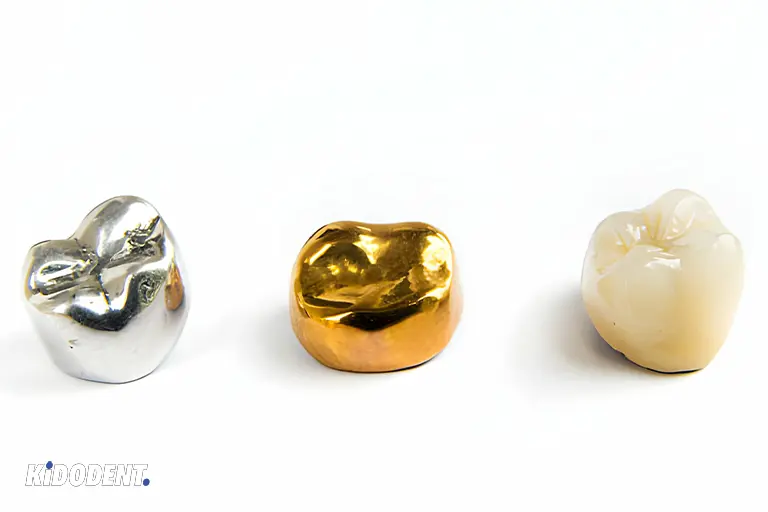A crown is a restorative cap that is cemented over damaged and severely worn-down teeth. Crowns can be made of different materials to satisfy our needs in both the function of teeth and esthetics for our smile.
Who needs a dental crown?
The choice over crown or other restorative methods like veneers and dental bonding requires an understanding of the type of dental condition, the amount of dental work, the age of the patient, patient’s desire, and the cost of the restoration that is needed.
In the following conditions, we need a crown restorative method or tooth crowning:
- In fixed bridges and removable dentures
- Severely worn and weekend teeth
- In conditions in which dental pulp treatment has caused fragile conditions for teeth
- Fractured and severely cracked teeth
- High degree of dental decay that has resulted in deep dental caries
- Having a large gap between teeth
- Receding soft tissues around teeth
- In dental implants
Types of tooth crown materials
Your dentist will help you choose the right type of material if you need a crown treatment. Costs, corrosion resistance, location of your tooth, and strength of the material are some essential factors when choosing the best restorative material for your crown.
Metal-ceramic dental crown (porcelain)
Metal-ceramic crown has both the beauty of ceramic and the strength of metal. Porcelain-fused-to-metal crown is another name for metal-ceramic crowns. The cast (the mold or the prepared area of tooth to fill the material with) is metal and the porcelain is used to cover the metal casting
Alloys are metallic mixtures or combinations that are used to restore the crown in the remaining tooth structure or in dental bridges. Depending on the cost, adherence, esthetic factors, strength, and condition of the teeth, this type of crown can provide the desired strength together with porcelain.
Metal crowns
Dental crowns made of metal can range from expensive metals that are called noble like gold, palladium, and silver to the less expensive metals like nickel, chromium, and beryllium.
For example, gold crown is the most strong type of material and a highly successful dental crown. Metal or let’s say alloys in metal combinations provide the strength and recommended rigidity for a longer time. On the other side, porcelain provides a natural, tooth-like color and more importantly the beauty of the restoration of teeth in the long run.
All-ceramic dental crown
We know how important restoration with the best tooth-like materials is. This is why dentists in laboratory and manufacturers in dental industry have come up with the solution to use ceramic materials to provide both esthetics and strength. The all-ceramic crown restorations with different ceramic materials are as follow:
- Feldspathic porcelain crown: it is a material as a veneer to cover the metal structure in tooth restoration. Feldspathic porcelain because of high translucency is a great option for anterior teeth and has high esthetic results. It also offers low amount of tooth reduction or we can say it has a minimal invasive intervention.
- IPS Empress crown: it is a leucite glass-ceramic material. IPS Empress not only has the translucency and simple application, it is also the best for long periods of time among the materials in the all-ceramic crowns.
- IPS e.max crown: IPS e.max crown is another all-ceramic dental material. With the component of lithium disilicate, IPS e.max is the material not just for anterior and posterior crowns but for many restorative types like veneers, inlays, onlays and in dental bridges. It has high translucency and with great strength to give our teeth the beauty of natural teeth.
- Zirconia crown: with new technologies CAD (computer aided design) and CAM (computer-assisted manufacture), zirconia crown ceramic can not only provide single crown restoration but produce easily all teeth in the arch. Zirconia has the highest strength among tooth-color materials. Final porcelain veneer finishing at the end offers a more beautiful look for your teeth.
Preparation for dental crown
The crown materials are just part of the story. One important part of preparation of the crown is the least soft tissue injuries and gum tissue damage. The restoration begins with tooth reduction (depending on the material type that is going to be used, reduction varies in occlusal, cuspal and facial in millimeters). Reduction is done to remove the caries and remove the structure to make it possible for the contour and the necessary thickness of the materials to be impressed.
The margin between the natural remaining structure of tooth and the dental crown is another important step in preparation. Dentists need to know the size or the contour for the crown fabrication. Impression of the model is sent to the laboratory to be made with the crown materials. Meanwhile, patients should wear the temporary crowns that are made according to the occlusal of the patients’ teeth for 3 to 4 weeks. The crown cap that is made should be seated in the prepared tooth with either cementation or bonding agents.
Shading and the color matching is important factor for the unity of a beautiful teeth look. Many factors play roles in providing highly acceptable crowns and new technologies have made it much easier to make it possible.
Caring tips for dental crown
Patients should follow daily oral hygiene home care tips. Oral health should be examined during visits to the dentist. For good maintenance of the crown and oral health, we need to follow these tips:
- Brushing daily with great care and not with force
- Do not chew on hard and harsh foods
- Using mouthwashes and mouth cleaning rinses
- Daily flossing
- Avoid sugary drinks and food or use xylitol containing products instead
- Regular appointment to monitor and test bacterial level and salivary flow in the mouth
